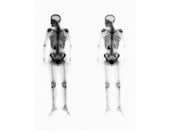Osteoporosis in intertrochanter more likely in women with high urinary triclosan concentration
WEDNESDAY, June 26, 2019 (HealthDay News) — Urinary triclosan (TCS) concentration is negatively associated with bone mineral density (BMD) and positively associated with osteoporosis, according to a study published online June 25 in the Journal of Clinical Endocrinology & Metabolism.
Shaofang Cai, from The Second Affiliated Hospital of Xiamen Medical College in China, and colleagues used data from the 2005 to 2010 National Health and Nutrition Examination Survey to examine the correlation of urinary TCS concentration with BMD and osteoporosis in 1,848 U.S. women.
The researchers found that relative to tertile 1 of TCS concentration, there were significant associations between tertile 3 of TCS concentration and lower BMD in the regions of the total femur, intertrochanter, and lumbar spine after adjustment for covariates (β = −0.016, −0.022, and −0.014, respectively). Women in tertile 3 were more likely than those in tertile 1 to have increased osteoporosis prevalence in intertrochanter (odds ratio, 2.464).
“Laboratory studies have demonstrated that triclosan may have potential to adversely affect the bone mineral density in cell lines or in animals. However, little is known about the relationship between triclosan and human bone health,” one coauthor said in a statement. “As far as we know, this is the first epidemiological study to investigate the association between triclosan exposure with bone mineral density and osteoporosis in a nationally representative sample from U.S. adult women.”
Copyright © 2019 HealthDay. All rights reserved.








